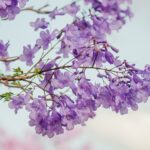Step into the enchanting world of the indigo plant, where nature’s wonders await to be explored. In this captivating article, we delve into the remarkable properties that make the indigo plant a true botanical marvel. Prepare to be mesmerized as we unlock the secrets behind its vibrant hues, therapeutic potential, and rich historical significance. Get ready to embark on a journey of discovery as we unravel the mysteries of this fascinating plant and uncover its extraordinary properties. Join us as we shine a spotlight on the indigo plant’s myriad of exceptional qualities, inviting you to marvel at the wonders that lie within its very essence.

Properties of Indigo Plant
Indigo plants, with their stunning purple and pink flowers, are not just a visual delight but also possess remarkable properties that make them a valuable natural resource. As an experienced botanist deeply passionate about the study of plants and their properties, I have delved into the world of the indigo plant, uncovering its unique characteristics, diverse uses, and historical significance. Join me on this journey as we explore the extraordinary properties of the indigo plant and unlock its botanical wonders.
Anti-inflammatory Properties:
One of the most fascinating properties of the indigo plant is its ability to combat inflammation in the body. Inflammation is a natural response in the body to injury or infection, but when it becomes chronic, it can contribute to the development of various diseases. The indigo plant’s anti-inflammatory properties can help alleviate inflammation and reduce its harmful effects on the body.
Indigo Plant
Have you ever heard of the magical indigo plant? It’s a fascinating plant that has been used for centuries to create a rich blue dye. The indigo plant is known for its vibrant hue and its ability to create beautiful textiles. If you’re interested in learning more about this incredible plant, click here to explore our detailed guide on the indigo plant. You’ll discover its history, cultivation techniques, and even how to dye fabrics using indigo. Don’t miss out on this captivating opportunity to delve into the world of the indigo plant and uncover its secrets. Click here to embark on this exciting journey: Indigo Plant.
FAQ
Question 1: What are the anti-inflammatory properties of the indigo plant?
Answer 1: The indigo plant possesses anti-inflammatory properties that have the potential to reduce inflammation within the body. These properties may be beneficial in alleviating inflammatory conditions.
Question 2: How can the indigo plant protect against infections?
Answer 2: The indigo plant exhibits antimicrobial properties, which can aid in protecting against various infections. These properties may help prevent the growth and spread of harmful microorganisms.
Question 3: What makes indigo a sustainable alternative to chemical dyes?
Answer 3: Indigo possesses natural dyeing capabilities, making it a sustainable alternative to chemical dyes. This means that it can be used to color textiles and materials without harming the environment or the individuals using them.
Question 4: What are the preferred growing conditions for indigo plants?
Answer 4: Indigo plants thrive in fertile, well-drained soil, moderate moisture, and full sun. In very hot climates, they appreciate some shade. These plants grow to a height of 2 to 3 feet and spread as medium shrubs.
Question 5: What are the medicinal properties associated with Indigo naturalis?
Answer 5: Indigo naturalis is believed to possess various medicinal properties, including alleviating pain, antipyretic (fever-reducing), anti-inflammatory, antiviral, antimicrobial, antitumor, and detoxifying effects. It has been widely used in China and Taiwan to treat psoriasis, infections, and inflammatory diseases.
- China II Review: Delicious Food & Speedy Service - April 17, 2025
- Understand Virginia’s Flag: History & Debate - April 17, 2025
- Explore Long Island’s Map: Unique Regions & Insights - April 17, 2025
















